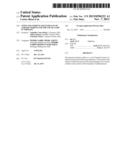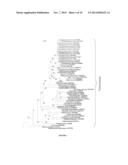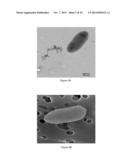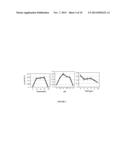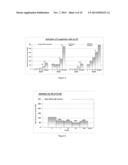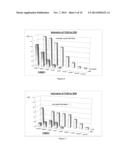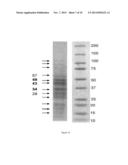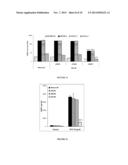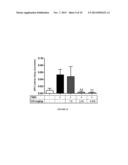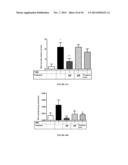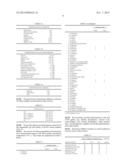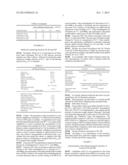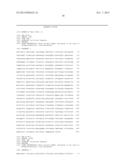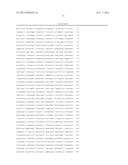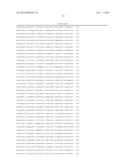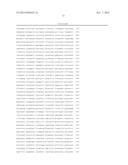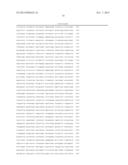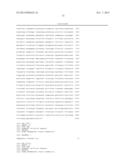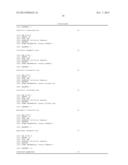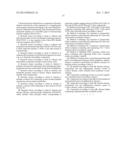Patent application title: NOVEL BACTERIUM AND EXTRACTS OF SAID BACTERIUM AND THE USE OF SAME IN THERAPY
Inventors:
Nathalie Castex Rizzi (Colomiers, FR)
Thien Nguyen (Rouffiac-Tolosan, FR)
Christine Libon (Castanet-Tolosan, FR)
Assignees:
PIERRE FABRE MEDICAMENT
PIERRE FABRE DERMO-COSMETIQUE
IPC8 Class: AA61K3574FI
USPC Class:
514 11
Class name: Drug, bio-affecting and body treating compositions designated organic active ingredient containing (doai) peptide (e.g., protein, etc.) containing doai
Publication date: 2013-11-07
Patent application number: 20130296222
Abstract:
The present invention relates to a novel bacterial strain isolated and
characterized from groundwater. The invention also relates to bacterial
extracts and to the therapeutic use of same, notably in the context of
the treatment of inflammations.Claims:
1. Bacterial extract obtained from a suspension of bacteria, wherein said
bacteria of the suspension is a nonpathogenic Gram-negative bacterium
belonging to the class Betaproteobacteria, subfamily Neisseriaceae, and
characterized in that a nucleotide sequence of a 16S rRNA gene of said
bacterium includes sequence SEQ ID NO: 1.
2. Bacterial extract according to claim 1, wherein said bacterium includes at least one plasmid comprising sequence SEQ ID NO: 2, or any sequence with at least 80% identity with said sequence SEQ ID NO: 2.
3. Bacterial extract according to claim 1, wherein said bacterium is the bacterium deposited with the CNCM on Apr. 8, 2010, under the reference 1-4290, or any other mutant of said bacterium.
4. Bacterial extract according to claim 1, wherein it is obtained after treatment of said bacterial suspension in such a way as to eliminate intracellular components.
5. Bacterial extract according to claim 4, wherein said intracellular components include at least nucleic acids.
6. Bacterial extract according to claim 4, wherein it includes a fraction E0 comprising at least membrane proteins, periplasmic proteins and proteins arising from the flagellum.
7. Bacterial extract according to claim 6, wherein said membrane proteins consist of porins, OmpA, lipopolysaccharides and/or lipoproteins.
8. Bacterial extract according to claim 4, wherein it includes a fraction SO comprising at least secreted peptides and proteins and secondary metabolites.
9. Bacterial extract according to claim 4, wherein it includes a fraction ES0 comprising at least fraction E0 and fraction SO.
10. Bacterial extract according to claim 9, wherein said fraction ES0 has a protein profile, obtained by SDS-PAGE, which includes three principal bands corresponding to molecular weights ranging between 30 kDa and 36 kDa, 41 kDa and 45 kDa, and 47 kDa and 51 kDa, respectively.
11. Method of activating TLR2, TLR4 and/or TLR5 which comprises contacting cells expressing TLR2, TLR4 and/or TLR5 with a bacterial extract according to claim 1.
12. Method of returning Th1 responses to homeostasis, which comprises contacting cells expressing Th1 with a bacterial extract according to claim 1.
13. Method of returning Th2 responses to homeostasis, which comprises contacting cells expressing Th2 with a bacterial extract according to claim 1.
14. Method of returning Th1 7 responses to homeostasis, which comprises contacting cells expressing Th1 7 with a bacterial extract according to claim 4.
15. Method of inhibiting PAR2 activation, which comprises contacting cells expressing PAR2 with a bacterial extract according to claim 8.
16. Method of treating and/or preventing gastrointestinal and/or oral inflammator diseases which comprises, administering to a patient in need thereof an effective amount of a bacterial extract according to claim 1.
17. The method according to claim 16, wherein said gastrointestinal and oral inflammatory diseases consist of Crohn's disease, colitis, irritable bowel syndrome or periodontitis.
18. Composition comprising at least, as an active ingredient, a bacterial extract according to claim 1.
19. Composition according to claim 18, for the treatment of gastrointestinal and oral inflammatory diseases.
20. Composition according to claim 19, wherein said gastrointestinal and oral inflammatory diseases consist of Crohn's disease, colitis or periodontitis.
21. Composition according to claim 18, wherein further comprising a pharmaceutically acceptable carrier.
Description:
[0001] The present invention relates to a novel bacterial strain isolated
and characterized from groundwater. The invention also relates to
bacterial extracts and to the therapeutic use of same, notably in the
context of the treatment of inflammations.
[0002] More particularly, the present invention relates to novel compositions of interest in the treatment and the prevention of chronic intestinal inflammatory disorders and periodontitis.
[0003] Acute colitis, irritable bowel syndrome and Crohn's disease are diseases that are increasing in developed countries and affect approximately 1.4 million Americans. (Arijs, I. et al., 2009. PLoS ONE.4:e7984, and Hill, D.A. and D. Artis. 2010. Annu. Rev. Immunol. 28:623-67 and Kaser, A. et al., 2010. Annu. Rev. Immunol. 28:573-621). Crohn's disease, an inflammatory intestinal disease, affects segments of the digestive tract, but its preferential sites are the ileum (terminal portion of the small intestine) and the colon. The wall of the affected intestine is edematous. During its progression, this edema of the intestinal wall will cause a decrease in the diameter of the intestine. Evolution toward fibrosis, a source of stenosis (contraction), may also occur.
[0004] The disease is characterized by the presence of ulcerations, more or less wide and more or less deep, which pass through the wall (fissures) thus causing abscess and fistulas. This disease affects both sexes and appears in general between the ages of 20 and 40. In its typical form, it begins slowly and insidiously. Episodic diarrhea and indistinct abdominal pain summarize the symptomatology for months or years.
[0005] When the disease has firmly taken hold, diarrhea of moderate intensity, sometimes fatty and seldom bloody, is the principal symptom. Fixed and continuous pain in the right iliac fossa or paroxysmal or atypical pain is also associated with the disease. Weight loss and fever are other important symptoms. The signs vary according to the topography of the lesions.
[0006] The disease progresses by flare-ups that are variable in intensity and that often regress spontaneously.
[0007] Complications are, however, frequent and they may require multiple surgical procedures: intestinal obstruction, intestinal fistulas, intestinal perforations, fistulas (openings) in the skin or in intra-abdominal organs, anorectal complications (fissures, abscesses).
[0008] Aside from surgical procedures, treatments with monoclonal antibodies (anti-TNF, anti-IL-12/p40 or anti-IL-23/p40) exist to palliate Crohn's disease but they have the disadvantage of being very costly.
[0009] The invention of the present patent application, in this context, proposes a different, effective and much less costly approach for relieving patients suffering from this disease.
[0010] Crohn's disease is multifactorial and complex. One of the factors identified in this disease is immunological in nature. Recent publications have revealed that the immune system of the host is "disrupted": pro-inflammatory and inflammatory reactions have proven to be disproportionate and exacerbated. A deregulation of the immune system is suggested: Th1 profile potentiated with production of IL-12, Th17 profile potentiated with an increase in IL-23, disruption of the natural flora of the intestine and impaired tolerance, which leads to inappropriate local and systemic immune responses resulting in immune responses against the aberrant intestinal flora leading to pathogenesis (activation of T cells, inflammatory cytokines, antibodies against intestinal bacteria) (Abraham C. and Cho J. H., N Engl J Med 2009; 361:2066-78).
[0011] Cenac et al., (Am J Pathol. 2002. 161:1903-1915) discovered that the activation of proteinase-activated receptor-2 (PAR2) induced acute intestinal inflammation in animals. PAR2 is overexpressed in the gastrointestinal tract: endothelial cells, colonic myocytes, enterocytes, enteric neurons, immune cells, etc. Proteases (trypsin, tryptase) present in abundance in the gastrointestinal tract cleave the PAR2 at the N-terminal exposing a specific peptide which activates this same receptor (phenomenon of self-activation). Consequently, this activates the production of pro-inflammatory cytokines and triggers inflammation (Vergnolle, N. 2005. Gut. 54:867-874 and Vergnolle, N. 2009. Pharmacol. Ther. 123:292-309). This phenomenon is observed in the wild mouse but does not appear in the KO mouse (PAR2 deficient). Treatment with an antiprotease and/or a PAR2 antagonist makes it possible to avoid this inflammation phenomenon.
[0012] Similar to gingivitis, periodontitis is an inflammatory disease of the periodontium, i.e., specialized tissues that surround and support the teeth: the gum, the cementum, the periodontal ligament and the alveolar bone. It is often accompanied by alveoloclasia (bone loss). Chronic periodontitis may appear at any age but is more common in adults. It is multifactorial (genetic and environmental factors). Chronic periodontitis is initiated and maintained by dental bacterial biofilm.
[0013] However, immune defense mechanisms play an important role in its pathogenesis. Recent studies revealed that PAR2 plays an important role in periodontitis because it is expressed in osteoblasts, in oral epithelial cells and in gingival fibroblasts (Holzhausen, M. et al., 2006. Am J Pathol. 168:1189-1199).
[0014] It has been reported that gingipain-R proteases produced by Porphyromonas gingivalis (major pathogen in chronic periodontitis) are able to activate PAR2 by proteolytic cleavage of the N-terminal thus exposing a specific peptide which activates this same receptor (phenomenon of self-activation) (Abraham, L. A. et al., 2000. Bone. 26:7-14 and Lourbakos, A. et al., 2001. Infect. Immun. 69:5121-5130). This induces the production of pro-inflammatory cytokines followed by inflammation which results in bone loss.
[0015] Therapy targeting protease inhibition or the use of a PAR2 antagonist constitutes a possible approach for modulating pathologies of infectious origin such as an inflammatory disease like periodontitis.
[0016] In this context, the present invention provides a solution to the treatment of these inflammatory disorders by the isolation, the characterization and the fractionation of a novel bacterium never before described.
[0017] For the first time, and in a surprising manner, the Applicant succeeded in isolating a strain belonging to a novel bacterial species from groundwater, wherein said novel bacterial strain (or bacterium) is named LMB64.
[0018] This bacterium LMB64, in addition to the fact of having been isolated, was characterized and defined as belonging to the class of Betaproteobacteria, subfamily of Neisseriaceae, and probably of a novel genus not yet defined. Analysis of the gene sequence coding for 16S rRNA made it possible to place this bacterium close to the genera Chromobacterium, Paludimonas, Lutelia and Glubenkiana, with which it shares 95% sequence similarity.
[0019] This nonpathogenic bacterium is Gram-negative and will be described in greater detail in the examples. This bacterium also has the characteristic of being nonfilamentous. Moreover, this bacterium has the advantage of being able to be cultured on a medium containing any type of water, and more particularly, ordinary water. As an example, in contrast to Vitreoscilla filiformis (V. filiformis), the culture of bacterium LMB64 of the present invention does not require particular culture conditions and, more particularly, does not require a medium containing at least one sulfur-free type of mineral and/or thermal water (mention may be made in this respect to the patent document EP2018891 (Gueniche A., 2009) and the document by Gueniche et al. 2006 (European Journal of Dermatology, 16, 4, 380-384) which describe the use of a bacterial extract of V. filiformis for the treatment of atopic dermatitis). This represents a clear advantage in terms of both culture conditions and facilities and from an economic point of view.
[0020] The gene coding for 16S rRNA has been almost completely sequenced (1487 bp). Bacterium LMB64 has a circular plasmid of 10948 bp. This plasmid was completely sequenced and the sequence is represented in sequence SEQ ID No. 2.
[0021] According to a first embodiment, the present invention relates to a nonpathogenic Gram-negative bacterium belonging to the class of Betaproteobacteria, subfamily of Neisseriaceae, whose nucleotide sequence of the gene coding for 16S rRNA includes or comprises the sequence SEQ ID No. 1, or any nucleotide sequence with at least 80%, preferably 85%, 90%, 95% and 98% identity with said sequence SEQ ID No. 1.
[0022] In a preferred manner, the present invention relates to a nonpathogenic Gram-negative bacterium belonging to the class of Betaproteobacteria, subfamily of Neisseriaceae, characterized in that the nucleotide sequence of the 16S rRNA gene of said bacterium includes or comprises the sequence SEQ ID No. 1.
[0023] In the context of the present invention, "percentage identity" between two nucleic acid sequences refers to a percentage of identical nucleotides between the two sequences to be compared, obtained after the best alignment (optimal alignment), wherein this percentage is purely statistical and the differences between the two sequences are distributed randomly and over their entire length. Comparisons of sequences between two nucleic acid sequences are normally made by comparing these sequences after having aligned them in an optimal manner, wherein said comparison may be made per segment or per "comparison window." The optimal alignment of the sequences for the comparison can be carried out, in addition to manually, by means of the local homology algorithm of Smith and Waterman (1981) [Ad. App. Math. 2:482], by means of the local homology algorithm of Needleman and Wunsch (1970) [J. Mol. Biol. 48:443], by means of the similarity search method of Pearson and Lipman (1988) [Proc. Natl. Acad. Sci. The USA 85:2444] or by means of computer software using these algorithms (GAP, BESTFIT, FASTA and TFASTA in the Wisconsin Genetics Software Package, Genetics Group Computer, 575 Science Dr., Madison, Wis., or the BLAST N or BLAST P comparison software).
[0024] The percentage identity between two nucleic acid sequences is determined by comparing these two aligned sequences in an optimal manner wherein the nucleic acid sequence to be compared may include additions or deletions in relation to the reference sequence for an optimal alignment between these two sequences. Percentage identity is calculated by determining the number of positions for which the nucleotide is identical between the two sequences, by dividing this number of identical positions by the total number of positions in the comparison window and by multiplying the result obtained by 100 to obtain the percentage identity between these two sequences.
[0025] For example, the "BLAST 2 sequences" program (Tatusova et al., "Blast 2 sequences--a new tool for comparing protein and nucleotide sequences," FEMS Microbiol Lett. 174:247-250), available at http://www.ncbi.nlm.nih.gov/gorf/b12.html, may be used with the default parameters (in particular for the parameters "open gap penalty": 5, and "extension gap penalty": 2; with the selected matrix being for example the "BLOSUM 62" matrix proposed by the program), with the percentage identity between the two sequences to be compared being calculated directly by the program. It is also possible to use other programs such as the "ALIGN" or "Megalign" software (DNASTAR).
[0026] According to another embodiment, the bacterium according to the invention includes at least one plasmid comprising sequence SEQ ID No. 2, or any sequence with at least 80%, preferably 85%, 90%, 95% and 98% identity with said sequence SEQ ID No. 2.
[0027] In a preferred manner, bacterium LMB64 includes at least one plasmid comprising sequence SEQ ID No. 2.
[0028] According to a preferred embodiment of the invention, bacterium LMB64 is characterized in that it is nonfilamentous.
[0029] Other characteristics of said bacterium LMB64 will be detailed below in the examples.
[0030] Moreover, bacterium LMB64 of the present invention has been deposited in the name of the Applicant with the Collection Nationale de Cultures de Microorganismes (CNCM), Institut Pasteur, Paris, on Apr. 8, 2010, under the reference I-4290.
[0031] Thus, one object of the invention is the bacterium deposited with the CNCM on Apr. 8, 2010, under the reference I-4290, or a homologue, a descendant or any other mutant.
[0032] The term "mutant" refers to any bacterium directly arising from strain I-4290 and may comprise natural mutations or recombinations, such as, for example, any recombination related to cell proliferation, cell division (mutation due to errors occurring during bacterial division or DNA replication) or any other mechanism of natural selection or of selection in culture media, such as the selection of mutants that are resistant or that become resistant to a given compound. Included among these mutants are any bacteria arising from strain I-4290 comprising one or more mutations in their genomic sequence (or that of their plasmid), in which the mutations were caused by radiation, by a virus, by transposons or by mutagenic chemicals.
[0033] According to a first embodiment of the invention, from a bacterial culture, the entire biomass may be isolated by various known methods such as, for example, by filtration, coagulation with an alcohol (ethanol, isopropanol, isobutanol), by drying on a cylinder with a scraped prelayer, etc., and then used in freeze-dried or heat-inactivated form.
[0034] According to another preferred embodiment, the invention relates in a general manner to a bacterial extract, also called a bacterial fraction, obtained from a suspension of bacteria as described above, namely bacterium LMB64.
[0035] The term "bacterial extract" refers to any extract or fraction of the bacterial biomass or any active fraction of said extract. For example, such an extract may be obtained from a culture of bacterium LMB64 wherein the preparation method comprises at least one step of lysis of the bacteria and one step of separation of the various fractions of which it is constituted by centrifugation or by filtration.
[0036] In a nonrestrictive manner, the extract according to the invention may consist of bacterial cells isolated from the culture medium which have been concentrated, for example by centrifugation; or concentrated bacterial cells which have undergone an operation in which the cell envelope has been ruptured by any means known to those persons skilled in the art, such as by the action of ultrasound or autoclaving; or the supernatant obtained by filtration.
[0037] An important step of the extract preparation method according to the invention consists of the elimination of the various intracellular components such as, for example, nucleic acids (chromosomal DNA, extrachromosomal circular DNA, plasmids), ribosomes and intracellular stored substances such as glycogen, starch and poly-β-hydroxybutyrate, etc.
[0038] In a preferred manner, the bacterial extract according to the invention is obtained after treatment of said bacterial suspension in such a way as to eliminate the intracellular components.
[0039] The result is that the extract according to the invention primarily includes components arising from the membrane, from the periplasmic space and/or from the extracellular space.
[0040] More particularly, said intracellular components comprise at least the nucleic acids.
[0041] In addition to the elimination of intracellular compounds, and as a nonrestrictive example, it is also easily possible for those persons skilled in the art to separate, after lysis of the bacteria and centrifugation, the components of the culture supernatant (hereafter fraction S0) and the components constituting the pellet (hereafter E0). For example, it may be suggested that the separation threshold between the constituents of S0 and E0 is around a molecular weight of 100 kDa. Consequently, the constituents of fraction S0 have, for the most part, a molecular weight less than 100 kDa, whereas the components of fraction E0 have, for the most part, a molecular weight greater than 100 kDa.
[0042] More particularly, it is thus possible by techniques known to those persons skilled in the art to extract and separate the biomolecules found in the culture supernatant (S0) from those mainly comprised of surface proteins and proteins located in the periplasmic space of the bacterium (E0).
[0043] According to one embodiment of the invention, the bacterial extract includes a fraction E0 comprising at least membrane proteins, periplasmic proteins and proteins arising from the flagellum.
[0044] Periplasmic proteins include proteins lodged in the periplasmic space of Gram-negative bacteria which may be released by osmotic shock or by incubation in a medium containing a chaotropic agent or detergents (Molecular Cloning: A Laboratory Manual, 3rd edition: Sambrook and Russell. CSHL Press).
[0045] Proteins arising from the flagellum include multimeric proteins of the flagellum or fragments of the flagellum. Methods for isolating and purifying whole bacterial flagella with detergents followed by ultracentrifugation separations (in the presence of a CsCl gradient) are described in the literature. In the invention, the examples of extraction methods made it possible to recover flagella fragments.
[0046] Membrane proteins include proteins that are anchored in the membrane and of which a part is exposed on the surface (such as outer membrane proteins, or Omp), proteins that are adhered to the surface of the membrane, lipoproteins and porins (Ward J B., Microbial adhesion to surfaces, 1980).
[0047] In a preferred manner, said membrane proteins consist of porins, OmpA, lipopolysaccharides and/or lipoproteins.
[0048] According to another embodiment of the invention, it may be preferred to use fraction S0.
[0049] More particularly, the bacterial extract according to the invention includes a fraction S0 comprising at least secreted peptides and proteins and secondary metabolites.
[0050] Secreted peptides and proteins include peptides and proteins that are naturally produced and secreted by bacterium LMB64 and which may be recovered by centrifugation or by filtration.
[0051] Secondary metabolites include the small molecules that bacterium LMB64 produces and secretes in the culture medium.
[0052] The presence of lipopolysaccharides within fraction S0 should be mentioned here. Indeed, lipopolysaccharides, although they are found primarily in fraction E0, are nevertheless also found in smaller quantities in fraction S0.
[0053] In an advantageous manner, fractions E0 and S0 may be combined in such a way as to obtain a fraction ES0 by leaving, for example, the culture medium to incubate and to react in basic medium (pH 9 to 11) for approximately 5 hours a temperature of 4° C., by centrifuging and by filtering at 0.2 μm in order to obtain a clear ES0 solution.
[0054] Bacterial extract ES0 is thus composed, among other things, of membrane proteins, lipopolysaccharides, periplasmic proteins, protein fragments of the flagellum and primary and secondary metabolites produced by the bacterium.
[0055] In a preferred way, extract ES0 has a protein profile comprising at least, according to the SDS-PAGE technique, twelve bands including three principal bands corresponding, respectively, to molecular weights (approximately in relation to molecular standards from Bio-Rad) ranging between:
[0056] band 1: 30 kDa and 36 kDa, preferentially 34 kDa;
[0057] band 2: 41 kDa and 45 kDa, preferentially 43 kDa;
[0058] band 3: 47 kDa and 51 kDa, preferentially 49 kDa.
[0059] According to another embodiment of the invention, the bacterial extract includes a fraction ES0 comprising at least fraction E0 and fraction S0.
[0060] According to a preferred embodiment of the invention, the bacterial extract includes a fraction ES0 with a protein profile, obtained by SDS-PAGE, which includes three principal bands corresponding to molecular weights ranging between 30 kDa and 36 kDa, 41 kDa and 45 kDa, and 47 kDa and 51 kDa, respectively.
[0061] According to a preferred embodiment of the invention, the bacterial extract includes a fraction ES0 with a protein profile, obtained by SDS-PAGE, which includes three principal bands corresponding to molecular weights of 34 kDa, 43 kDa and 49 kDa, respectively.
[0062] According to another aspect, the invention describes a method for preparing a bacterial extract comprising the steps of:
[0063] a) culturing bacterium LMB64 in a suitable medium; and
[0064] b) eliminating the intracellular components.
[0065] According to another embodiment, the method according to the invention consists of a method for preparing a bacterial extract S0, wherein said method comprises the steps of:
[0066] a) culturing bacterium LMB64 in a suitable medium;
[0067] b) centrifuging said culture; and
[0068] c) recovering supernatant S0.
[0069] According to another embodiment, the method according to the invention consists of a method for preparing a bacterial extract E0, wherein said method comprises the steps of:
[0070] a) culturing bacterium LMB64 in a suitable medium;
[0071] b) centrifuging said culture and eliminating the supernatant;
[0072] c) treating the biomass resulting from step b) in such a way as to eliminate the intracellular components; and
[0073] d) recovering the pellet E0.
[0074] In a preferred manner, step c) consists of ultrasonic treatment of the biomass resulting from step b) and then an initial centrifugation aimed at eliminating the pellet comprising said intracellular components and then a second centrifugation of the supernatant.
[0075] According to another embodiment, the method according to the invention consists of a method for preparing a bacterial extract E0, wherein said method comprises the steps of:
[0076] a) culturing bacterium LMB64 in a suitable medium;
[0077] b) centrifuging said culture and eliminating the supernatant;
[0078] c) treating with ultrasound the biomass resulting from step b);
[0079] d) centrifuging said biomass treated with ultrasound and eliminating the biomass obtained;
[0080] e) centrifuging the supernatant resulting from step d); and
[0081] f) recovering the pellet E0.
[0082] It should be noted that the various methods described above are provided for illustration only and that any methods known to those persons skilled in the art may be used.
[0083] As will become apparent from the examples below, the Applicant has demonstrated, in addition to the activities expected for this type of extract, several novel activities never before described.
[0084] A first advantageous aspect of the invention, related to immunomodulation, rests on the modulation property of pro-inflammatory cytokines. More particularly, the use of a bacterium and/or an extract according to the invention is able, in the case of a response strongly oriented toward a Th1 or Th17 profile as with Crohn's disease, to restore homeostasis.
[0085] Another advantage of the invention rests on the fact that, as will be apparent from the examples, the use of a bacterium and/or an extract according to the invention induces the production of antimicrobial peptides such as, for example but without being restrictive, peptides hBD-2, hBD-3, S1007A and LL-31. These peptides have an antimicrobial effect on pathogens that colonize the intestinal tract without affecting the normal growth of commensal microflora. As a result, their action restores normal microflora in the intestine.
[0086] More particularly, as mentioned above, an extract of bacterium Vitreoscilla filiformis (Gueniche A. et al., 2006) has been known with activity on TLR2, due to the presence of OmpA, and on TLR4, due to the presence of lipopolysaccharides. Because of the absence of flagella in the V. filiformis bacterium, the extract obtained from V. filiformis has no TLR5 activity.
[0087] For the first time, the Applicant describes a bacterial extract according to the invention which has, in addition to activity on TLR2 and TLR4, activity on TLR5.
[0088] The invention thus relates to the use of a bacterium and/or a bacterial extract such as described above as an activator of TLR2, TLR4 and TLR5.
[0089] In a preferred manner, said bacterial extract activator of TLR2, TLR4 and TLR5 consists of an extract comprising all or part of the proteins arising from the flagellum. In this case, as an example, said extract is preferentially extract E0 or extract ES0.
[0090] Said TLR5 activation activity is of significant interest in that TLR5 are known to induce certain antimicrobial peptides such as psoriasin (S100A7) and hBD-2 (Glaser et al., Journal of Investigative Dermatology (2009) 129, 641-649). Moreover, TLR5 agonists act in synergy with those of TLR2 and TLR4, thus making it possible to potentiate the production of antimicrobial peptides. It has been shown that by blocking TLR5 with an antibody, the latter are produced little or not at all.
[0091] This aspect is thus particularly innovative in terms of immunomodulation applications for the bacterium and/or the extracts according to the invention.
[0092] Thus, the invention also has as an object a method for the treatment or prevention of pathology, in particular pathology related to an infection or to an immune response defect, wherein said pathology is associated with a defect in the activity of TLR2, TLR4 and TLR5, and wherein said treatment or prevention involves modulation of the activity, in particular an increase in the activity, of said TLR2, TLR4 and TLR5 by the administration of an activator of said receptors, wherein said method comprises the administration, to a patient who has or who is likely to have said pathology, of an effective quantity of a bacterium or a bacterial extract according to the present invention.
[0093] Furthermore, in an unexpected manner, the Applicant has also demonstrated, in contrast to the bacterial extracts described to date, antagonistic activity toward PAR2. This activity is of significant interest in the context of anti-inflammatory treatments.
[0094] The invention thus relates, quite particularly, to the use of a bacterium and/or a bacterial extract such as described above as a PAR2 antagonist.
[0095] The invention also has as an object a method for the treatment or prevention of pathology, in particular pathology related to inflammation, wherein said pathology is associated with a dysfunction of PAR2, and wherein said treatment or prevention involves modulation of the activity of said PAR2 particularly by the administration of an antagonist of said receptor, wherein said method comprises the administration, to a patient who has or who is likely to have said pathology, of an effective quantity of a bacterium or a bacterial extract according to the present invention.
[0096] In a preferred manner, said PAR2 antagonist bacterial extract consists of extract S0 or extract ES0.
[0097] PAR2 is overexpressed in endothelial cells, colonic myocytes, enterocytes, enteric neurons, immune cells and keratinocytes. Proteases (trypsin, tryptase) present in abundance in the environment cleave the PAR2 at the N-terminal exposing a specific peptide which activates this same receptor (phenomenon of auto-activation). Consequently, this activates the production of pro-inflammatory cytokines and triggers inflammation (Vergnolle, N. 2009, Pharmacol. Ther. 123:292-309). This phenomenon is observed in the wild mouse but does not appear in the KO mouse (PAR2 deficient). Treatment with an antiprotease and/or a PAR2 antagonist makes it possible to avoid this inflammation phenomenon.
[0098] The combination and the synergy of all these activities give this bacterium LMB64, or any extract arising from this same bacterium, a high potential to treat inflammatory diseases and, quite particularly, inflammatory diseases in which PAR2 is involved and/or in which the immune system is weakened, disturbed or unbalanced.
[0099] The invention thus relates to the use of a bacterium such as described above and/or a bacterial extract arising from said bacterium for the preparation of a composition intended for the treatment and/or the prevention of gastrointestinal and oral inflammatory disorders.
[0100] In a preferred manner, said gastrointestinal and oral inflammatory disorders consist of Crohn's disease, colitis or periodontitis.
[0101] According to another embodiment, the invention of the present patent application relates to a composition comprising, as an active ingredient, at least one bacterium and/or one bacterial extract according to the invention.
[0102] The composition according to the invention relates to the treatment of gastrointestinal and oral inflammatory disorders.
[0103] In a preferred manner, said gastrointestinal and oral inflammatory disorders consist of Crohn's disease, colitis or periodontitis.
[0104] The invention thus relates to a pharmaceutical composition further comprising a pharmaceutically acceptable carrier.
[0105] In the present description, "pharmaceutically acceptable carrier" refers to a compound or a combination of compounds made part of a pharmaceutical composition that do not cause secondary reactions and that, for example, facilitate the administration of the active compounds, increase their lifespan and/or effectiveness in the body, increase their solubility in solution or improve their preservation. Said pharmaceutically acceptable carriers are well known and will be adapted by those persons skilled in the art according to the nature and the mode of administration of the active compounds selected.
[0106] Preferably, said compounds may be administered systemically by intramuscular, intradermal, intraperitoneal or subcutaneous route, or by oral route. The composition comprising the antibodies according to the invention may be administered in several doses, spread out over time.
[0107] Their optimal modes of administration, dosing schedules and galenic forms may be determined according to criteria generally considered in the establishment of a treatment adapted to a patient such as, for example, the age or the weight of the patient, the seriousness of the patient's general health, tolerance to the treatment and side effects noted.
[0108] The invention will be better understood upon consideration of the examples below which illustrate the invention without limiting its scope.
DESCRIPTION OF FIGURES
[0109] FIG. 1 illustrates the phylogenetic position of the sequence coding for the 16S rRNA of strain LMB64. The sequences appearing on this tree are sequences from the GenBank database closest to the sequence of LMB64.
[0110] FIGS. 2A and 2B present images of bacterium LMB64 under the transmission electron microscope (A) and the scanning electron microscope (B).
[0111] FIG. 3 presents growth optima determined as a function of the temperature, pH and salinity of the R3 culture medium.
[0112] FIG. 4 illustrates induction of surface molecules CD80, CD86, CD83 and CD54 by extract E0 (dose-dependent effect).
[0113] FIG. 5 illustrates inhibition of IgE receptors by extract E0.
[0114] FIG. 6 illustrates activation of TLR2 by extract ES0.
[0115] FIG. 7 illustrates activation of TLR4 by extract ES0.
[0116] FIG. 8 illustrates activation of TLR5 by extract ES0.
[0117] FIG. 9 illustrates specific PAR2 antagonist activity by extract ES0.
[0118] FIG. 10 consists of an SDS-PAGE gel of extract ES0.
[0119] FIG. 11 demonstrates the effect of ES0 in the induction of TLR5-dependent expression of antimicrobial peptide genes.
[0120] FIG. 12 illustrates that ES0 activity on human oral keratinocytes is mediated by TLR5.
[0121] FIG. 13 illustrates the anti-inflammatory effect of ES0 in a model of acute colitis in the rat.
[0122] FIGS. 14A and 14B demonstrate that strain LMB64 administered preventatively significantly reduces intestinal lesions induced by TNBS [A] as well as the inflammatory response (MPO activity) [B].
EXAMPLE 1
Selection and Characterization of Bacterium LMB64
[0123] Bacterium LMB64 was isolated from groundwater.
[0124] The taxonomic position of novel bacterium LMB64 is proposed in FIG. 1.
[0125] More particularly, bacterium LMB64 is rod-shaped with a length of roughly 2.3 μm (±0.3) and a width of roughly 1.0 μm (±0.1). A distinctive characteristic of this bacterium is the presence of a polar flagellum (FIGS. 2A and 2B). As can also be seen in these images, bacterium LMB64 is a nonfilamentous bacterium.
[0126] As mentioned above, bacterium LMB64 has a circular plasmid of roughly 11 kpb. This plasmid was completely sequenced (SEQ ID No. 2).
[0127] The gene coding for 16S rRNA was also sequenced (SEQ ID No. 1). The bacterium was cultured in a fermentor in a synthetic medium. The growth rate is higher when the medium has a low concentration of carbon substrates.
[0128] The culture media tested are R3, MS-glucose and LB media whose compositions are described below in tables 1a, 1b and 1c, respectively.
TABLE-US-00001 TABLE 1a COMPOSITION OF R3 MEDIUM Yeast extract 1 g/l Difco proteose peptone 1 g/l Casamino acids 1 g/l Glucose 1 g/l Soluble starch 1 g/l Sodium pyruvate 0.5 g/l.sup. K2HPO4 0.6 g/l.sup. MgSO4, 7H2O 0.1 g/l.sup.
TABLE-US-00002 TABLE 1b COMPOSITION OF MS-GLUCOSE MEDIUM Glucose 6.0 g/l Citric acid 0.84 g/l MgSO4, 7H2O 0.25 g/l NH4Cl 1.06 g/l Anhydrous K2HPO4 8.75 g/l Pyruvic acid sodium salt 0.5 g/l Zinc sulfate, 7H2O 4 mg/l Cobalt chloride, 6H2O 3.5 mg/l Sodium molybdate, 2H2O 3.5 mg/l Manganese sulfate, 1H2O 5 mg/l Boric acid 2 mg/l Concentrated hydrochloric acid 50 mg/l Copper sulfate, 5H2O 4 mg/l Iron chloride, 6H2O 27 mg/l
TABLE-US-00003 TABLE 1c COMPOSITION OF LB MEDIA Tryptone 10 g/l Yeast extract 5 g/l NaCl 5 g/l
[0129] The growth rates of bacterium LMB64 as a function of culture medium are presented in table 2 below.
TABLE-US-00004 TABLE 2 Growth rate (/h) LB 0.25 (±0.05) LB (1/2 dilution) 0.46 (±0.11) LB (1/5 dilution) 0.60 (±0.14) LB ( 1/10 dilution) 0.69 (±0.15) MS-glucose 0.13 (±0.04) R3 0.62 (±0.14)
[0130] The growth optima were determined as a function of the temperature, pH and salinity of the R3 culture medium (FIG. 3).
[0131] The sources of carbon assimilable by the bacterium were characterized using an API 50CH gallery (incubation temperature: 25° C.). The results are summarized in table 3 below.
TABLE-US-00005 TABLE 3 Incubation time 4 days 5 days 1. Glycerol 2. Erythritol 3. D-arabinose 4. L-arabinose 5. D-ribose 6. D-xylose 7. L-xylose 8. D-adonitol 9. Methyl-β-D-xylopyranoside 10. D-galactose 11. D-glucose + + 12. D-fructose + + 13. D-mannose 14. L-sorbose 15. L-rhamnose 16. Dulcitol 17. Inositol l + 18. D-mannitol 19. D-sorbitol 20. Methyl-α-D-mannopyranoside 21. Methyl-α-D-glucopyranoside 22. N-acetylglucosamine 23. Amygdaline 24. Arbutin 25. Esculin/iron citrate 26. Salicin 27. D-cellobiose 28. D-maltose l + 29. D-lactose (bovine origin) 30. D-melibiose 31. D-sucrose + + 32. D-trehalose l + 33. Inulin 34. D-melezitose 35. D-raffinose 36. Starch 37. Glycogen 38. Xylitol 39. Gentiobiose 40. D-turanose l + 41. D-lyxose 42. D-tagatose 43.D-fucose 44. L-fucose 45. D-arabitol 46. L-arabitol 47. Potassium gluconate 48. Potassium 2-ketogluconate 49. Potassium 5-ketogluconate +: usable substrate, l: low use
[0132] The enzymatic activities demonstrated on the API ZYM gallery are: alkaline phosphatase, esterase (C4), esterase/lipase (C8), leucine arylamidase, valine arylamidase, acid phosphatase, naphthol-AS-BI-phosphohydrolase, and α-glucosidase.
[0133] Bacterium LMB64 is sensitive to all the antibiotics tested as seen in table 4 below.
TABLE-US-00006 TABLE 4 Zone of inhibition diameter (mm) Inhibitory Antibiotics tested R3 LB 1/2 LB 1/5 activity Ampicillin (10 μg) 29 28 29 + Chloramphenicol (30 μg) 29 26 24 + Ciprofloxacin (5 μg) 38 34 34 + Kanamycin (30 μg) 27 30 27 + Penicillin (6 μg) 21 26 20 + Polymyxin B (50 μg) 11 15 13 + Rifampicin (30 μg) 20 19 15 + Tetracycline (30 μg) 30 25 20 + Streptomycin (10 μg) 25 25 24 + Vancomycin (30 μg) 20 21 21 +
EXAMPLE 2
Method for extracting fractions E0, S0 and ES0
[0134] Preculture: Strain AV13 is inoculated in an Erlenmyer flask containing 250 ml of MS glucose pyruvate medium (see table 5 below), followed by incubation under stirring for roughly 40 hours at 30° C. (pH 7) and 200 rpm until an OD600≈1.5 is obtained.
TABLE-US-00007 TABLE 5 MS Glucose Pyruvate Citric acid 0.84 g MgSO4, 7H2O 0.25 g NH4Cl 1.06 g Anhydrous K2HPO4 8.75 g Pyruvic acid sodium salt 0.5 g Oligo mix 1 ml ddH2O qsp 1000 ml Verify pH 7 Autoclave 121° C. 30 min After autoclaving add: 20% glucose 30 ml OLIGO MIX Dissolve in 100 ml of distilled water: Zinc sulfate, 7H2O 4 g Cobalt chloride, 6H2O 3.5 g Sodium molybdate, 2H2O 3.5 g Manganese sulfate, 1H2O 5 g Boric acid 2 g Concentrated hydrochloric acid 50 g Copper sulfate, 5H2O 4 g Dissolve in 50 ml of distilled water: Iron chloride, 6H2O 27 g ddH2O qsp 1000 ml
[0135] Culture: The preculture is then inoculated in a fermentor (Applikon) containing 3.7 l of MS pyruvate medium+114 ml of 20% glucose solution. A temperature sensor regulates the temperature preferably near 30° C. An oxygen sensor (AppliSens) is used to maintain the concentration of dissolved oxygen in the medium at 18-25%. A pH sensor (AppliSens) is used to maintain the pH at 7 by the addition of 10% NH4OH via a fixed flow-rate pump. A Wedgewood Analytical sensor is used to monitor changes in optical density in real time. The culture is programmed in fed-batch mode; via a variable flow-rate pump the culture is supplied with 20% glucose solution. Fermentation is stopped when OD600≈22-26, in general after roughly 30 hours.
[0136] Extraction S0: The supernatant is separated from the biomass by centrifugation for 1 hour at 4° C. and 4000 g.
[0137] Extraction E0: The wet biomass is taken up in NaCl solution (1 M). After centrifugation for 15 minutes at 4° C. and 9000 g, the supernatant is discarded and the pellet is taken up in 1 M NaCl solution. The sample tube is then plunged into a cooled ultrasonic bath at a power setting of 50-60 W for several minutes. After centrifugation for 30 minutes at 4° C. and 6000 g, the pellet is discarded and the supernatant is recovered. Two volumes of cold ethanol are added and the suspension is left overnight at 4° C. After centrifugation for 30 minutes at 4° C. and 6000 g, the supernatant is discarded and the pellet is taken up in 25 mM Tris buffer, pH 8.8.
[0138] Extraction ES0: The culture is brought to basic pH (pH 9-11) with a base buffer. The next step is incubation under stirring for 5 hours at a temperature of 4° C. After centrifugation, the supernatant is prefiltered to eliminate remaining biomass debris and then filtered on a 0.2 μm filter. A clear yellow solution is obtained (ES0).
[0139] Proteins are assayed according to the DC Protein Assay Kit II (Bio-Rad) protocol. Sugars are assayed in glucose equivalent according to the phenol/sulfuric acid method (Dubois, M. et al., 1956).
[0140] As an example, table 6 below presents certain specific characteristics of extract ES0 as obtained under the conditions described above.
TABLE-US-00008 TABLE 6 Test batch Preclinical batch 1 Organoleptic Homogeneous and translucent yellow-orange liquid characteristics Density near that of water pH 10.0 10.2 (in the presence of base buffer) Dry residue 5.9% 5.1% (thermobalance) Protein profile 12 detectable bands (including 3 principal bands (SDS-PAGE) roughly 34 kDa, 43 kDa and 49 kDa in size, respectively) Total protein assay 2.9 mg/ml 3.0 mg/ml (μBCA)
[0141] It is clearly understood that the data above are presented here only for illustrative purposes.
[0142] More precisely, the data relate to a protein profile obtained by SDS-PAGE exhibiting three principal bands.
[0143] SDS-PAGE Protocol:
[0144] Extract ES0 is taken up in buffer (20 mM Tris-HCl, pH 8.0; 1 mM EDTA; 2.5% SDS and 0.01% bromophenol blue) and 1 M DTT (1,4-dithiothreitol). The sample and the mixture of molecular weight markers (WesternC, Bio-Rad) were deposited respectively in wells of an 8-16% SDS-PAGE acrylamide gel (GeBaGel, Gene Bio-Application). The migration buffer contains 2.5 mM Tris, 19.2 mM glycine and 0.01% SDS (w/v). Migration is allowed to proceed under a constant voltage of 160 V for approximately 1 hour (GeBaGel system). The protein bands were then stained with Coomassie Blue (Instant Blue, Expedeon). Sizes were calculated in relation to known standards (STD).
[0145] The gel obtained is presented in FIG. 10.
[0146] According to one embodiment of the invention, these three bands have molecular weights of approximately 34 kDa, 43 kDa and 49 kDa, respectively.
Example 3
Demonstration of the Pharmacological Activities of Fractions E0 and ES0
[0147] Langerhans cells (LC) are generated in vitro from human monocytes isolated from Buffy-Coat pouches from the French National Blood Service (Etablissement Francais du Sang (EFS) Pyrenees Mediterranee): isolation on a Ficoll gradient (Lymphocyte Separation Medium, density 1.077 g/ml) and purification by magnetic immunoselection (Miltenyi Biotec); LC differentiation is carried out for 6 days in the presence of a cytokine cocktail (GM-CSF/IL-4/TGFβ). LC distributed on 24-well plates in RPMI-5% FCS culture medium are incubated for 24 hours with extract ES0.
[0148] Surface molecules are analyzed by flow cytometry (FACSCalibur, BD Biosciences) with triple or quadruple staining: CD1a/CD54/CD80/CD83/CD86/FcεRI; cytokines secreted in the culture supernatants are analyzed with the Cytometry Bead Array (cat. no. 550749, BD) in flow cytometry: IL-6, IL-8, TNF, IL-4, IL-10, IL-12.
[0149] 3.1 Langerhans Cell Maturation and IgE Receptor (FcεRI) Inhibition
[0150] Extract E0 induces the maturation of Langerhans cells observed by dose-dependent induction of surface molecules CD80, CD86, CD83 and CD54 (FIG. 4). Similarly, extract E0 inhibits the expression of IgE receptors (FcεRI) according to a dose-dependent effect (FIG. 5).
[0151] 3.2 Activation of Toll-Like Receptors (TLRs)
[0152] The TLR activity of ES0 was evaluated on TLR2, TLR4 and TLR5 using the model of HEK293 cells cotransfected by the gene for TLR2, TLR4 or TLR5 and by the reporter gene NFκB-sAP (secreted alkaline phosphatase). The binding of a ligand to its TLR leads to the activation of the transcription factor NFκB; the sAP gene is placed under the control of a promoter that can be induced by NFκB. This reporter gene makes it possible to monitor cell signaling via TLRs: the release of sAP induced by ES0 and measured by colorimetric assay makes it possible to determine the activity of this active ingredient as a TLR2, TLR4 or TLR5 agonist.
[0153] The study was carried out on the following human embryonic kidney (HEK293) cell lines:
[0154] HEK-Blue®-2 cells for TLR2,
[0155] HEK-Blue®-4 cells for TLR4,
[0156] HEK-Blue®-5 cells for TLR5.
[0157] These cell lines are maintained in HEK-Blue® Selection 10% FCS culture medium and then distributed in 96-well plates in HEK-Blue® Detection medium in the presence of ES0 for 18 hours. The plates are read using calorimetry at 620 nm.
[0158] 3.2.1 Activation of TLR2
[0159] Extract ES0 induces the activation of TLR2 according to a dose-dependent effect with a maximum activity at 100 ng/ml (FIG. 6).
[0160] 3.2.2 Activation of TLR4
[0161] Extract ES0induces the activation of TLR4 with a maximum activity at 10 ng/ml (FIG. 7).
[0162] 3.2.3 Activation of TLR5
[0163] Extract ES0 induces the activation of TLR5 in a dose-dependent manner. This activity is inhibited in the presence of anti-TLR5 antibody, demonstrating the activation specificity of extract ES0 on TLR5 (FIG. 8).
[0164] 3.3 Inhibition of PAR2
[0165] The inhibition of protease-activated receptors by extract ES0 is evaluated on human keratinocytes from a cell line (HaCaT) by measuring the intracellular calcium influx induced after specific stimulation of PAR2 with stratum corneum tryptic enzyme (SCTE). The fluorescent probe Fluo-4/AM is used: its esterified form facilitates its penetration by passive diffusion in the cell; only the deesterified form bound to calcium ions is excitable under 485 nm fluorescence and emits at 535 nm.
[0166] The fluorescent probe is incorporated for 30 minutes in cells inoculated in 96-well plates and then extract ES0 is incubated for 30 minutes. Calcium flow is measured well by well in real time according to kinetics before and after injection of SCTE. The plates are read using a Mithras LB940® reader (Berthold Technologies®).
[0167] Extract ES0 inhibits in a dose-dependent manner activation of PAR2 induced by human SCTE (FIG. 9).
EXAMPLE 4
Use of Extract ES0 for the Treatment of Periodontitis
[0168] Periodontal diseases are chronic inflammatory diseases that can lead to the destruction of the periodontium. A change occurs in the bacterial flora comprising pathogenic anaerobic strains such as Porphyromonas gingivalis (Pg). These strains are sensitive to antimicrobial peptides which, at least for hBD-3, are found in lower quantities in the gingival crevicular fluid of subjects suffering from periodontal diseases (Brancatisano F L et al. (2011) Reduced human Beta defensin 3 in individuals with periodontal disease. J Dent Res. 90:241-245). In this experiment, we demonstrate that extract ES0 is able to induce antimicrobial peptides in oral keratinocytes.
[0169] Primary human oral keratinocytes were stimulated for 48 hours with 10 μg/ml of ES0, in the presence or the absence of 1 μg/ml of antibody specifically blocking each TLR: TLR2 (aTLR2), TLR4 (aTLR4) or TLR5 (aTLR5). Expression of the mRNA of various antimicrobial peptides (table 7 below) was quantified by real-time PCR.
TABLE-US-00009 TABLE 7 GENE PROTEIN DEFB103 hBD-3 DEFB4 hBD-2 S100A7 Psoriasin RNase7 RNase7
[0170] After 48 hours of stimulation, the cells were lysed and total RNA was extracted and then assayed using a NanoDrop N1000 spectrophotometer (Thermo Fisher Scientific). cDNA were synthesized from 1 μg is of RNA. The quantitative PCR amplification step was carried out using SYBR Green (SYBR Green PCR Core Reagents kit, Applied Biosystems) in 96-well plates. The DNA sequences of the primers used are presented in table 8 below.
TABLE-US-00010 TABLE 8 H-DEFB103A-U 5'-TGGGGTGAAGCCTA SEQ ID NO. 3 GCAGCTATG-3' H-DEFB103A-L 5'-ATGATTCCTCCATG SEQ ID NO. 4 ACCTGGAACA-3' H-DEFB4-U 5'-CCATCAGCCATGAG SEQ ID NO. 5 GGTCTTGTAT-3' H-DEFB4-L 5'-CGCCTATACCACCA SEQ ID NO. 6 AAAACACCTG-3' H-S100A7-19U 5'-CACTCATCCTTCTA SEQ ID NO. 7 CTCGTGACGC-3' H-S100A7-142L 5'-GGCTTGGCTTCTCA SEQ ID NO. 8 ATCTTGTCAT-3' H-RNASE7-U 5'-GAGTCACAGCACGA SEQ ID NO. 9 AGACCAAGC-3' H-RNASE7-L 5'-AGCAGCAGAAGGGG SEQ ID NO. 10 GCAGAA-3'
[0171] The values of the cycle threshold (Ct) were normalized in relation to reference genes (GAPDH: glyceraldehyde-3-phosphate dehydrogenase; PPIA: peptidylprolyl isomerase A; YWHAZ: tyrosine 3/tryptophan5-monooxygenase; RPLP0: ribosomal protein P0). The level of expression of the gene of interest is then given in ΔCt: ΔCt=Ct.sub.(gene of interest)-Ct.sub.(reference gene). The relative quantity (RQ) of messenger RNA for each gene of interest is calculated in relation to the corresponding untreated control cell:
RQ=2.sup.(-ΔΔCt), wherein ΔΔCt=ΔCt.sub.(treated cells)-ΔCt.sub.(control cells).
[0172] Expression of the gene of interest is considered regulated when RQ≧2 (induction) or RQ≦0.5 (inhibition).
[0173] The hBD-2 concentration in the culture supernatants was determined by ELISA using a commercial kit according to the manufacturer's recommendations (PeproTech). The results are expressed as mean±standard deviation and the percentage of inhibition of production induced, when significantly modulated, is indicated in bold blue (evaluated in relation to the production induced without antibody, "Without AB").
[0174] The results show that ES0 is a powerful inducer of the expression of all of the antimicrobial peptides studied (FIG. 11, "Without AB"). Overexpression of the DEFB4 gene is correlated with a large increase in hBD-2 protein secretion (FIG. 12).
[0175] After pre-incubation of the cells with an anti-TLR2 or anti-TLR4 antibody, peptide expression is not affected. On the other hand, in the presence of anti-TLR5 antibody, the expression of DEFB103, DEFB4, S100A7 and RNase 7 is strongly suppressed: 71%, 94%, 99% and 82%, respectively (FIG. 11). Similarly, hBD-2 secretion is drastically reduced by 82% with anti-TLR5 antibody alone (FIG. 12).
[0176] ES0 is thus a powerful activator of antimicrobial peptide expression and secretion. This effect is related to TLR5 activation. To date, the only known TLR5 ligand is flagellin. It is thus likely that LMB64 flagellin contained in ES0 is responsible for the activation of TLR5 and the production of antimicrobial peptides.
EXAMPLE 5
Use of Extract ES0 for the Treatment of Chronic Inflammatory Bowel Disease (IBD)
[0177] The effect of ES0 was evaluated on inflammatory response in experimental colitis. The rat model of acute colitis induced by TNBS (2,4,6-trinitrobenzenesulfonic acid) is known to approximate Crohn's disease. ES0 was administered rectally to avoid its degradation during passage in the gastrointestinal tract. It is shown herein that ES0 is able to contain inflammation via inhibition of myeloperoxidase (MPO).
[0178] The effect of living bacterium LMB64 by oral route as a preventive measure was also evaluated in IBD: the effect of strain LMB64 was evaluated in the rat model of acute colitis induced by TNBS. Living strain LMB64 was administered by oral route.
[0179] 5.1 Extract ES0
[0180] The effect of ES0 was evaluated on inflammatory response in experimental colitis. The rat model of acute colitis induced by TNBS (2,4,6-trinitrobenzenesulfonic acid) is known to approximate Crohn's disease. ES0 was administered rectally to avoid its degradation during passage in the gastrointestinal tract.
[0181] Groups of 10 Wistar rats received 30 mg of TNBS rectally at D0. Various doses of ES0 (7.5, 0.75 and 0.075 mg of proteins/kg) were administered daily from D0 to D6. The animals were sacrificed at D7 to determine the local inflammatory reaction by assaying the enzyme myeloperoxidase (MPO) present in neutrophils. Briefly, a section of colon was homogenized and MPO activity was quantified by spectrophotometric assay in the supernatant.
[0182] The results are expressed as mean±standard deviation.
[0183] A statistical analysis of the data was carried out using a one-way ANOVA followed by a Bonferroni test.
[0184] The administration of TNBS induces a significant increase in activity in relation to the untreated control group. In rats receiving ES0 at doses of 0.75 mg/kg or 0.075 mg/kg, but not at the strongest dose, MPO activity is significantly inhibited compared to the TNBS-treated positive control group. The effect of ES0 is powerful since MPO activity returns to normal, i.e., similar to that of the negative control group not treated with TNBS (FIG. 13).
[0185] 5.2 Bacterium LMB64 as a Preventive Measure in Chronic Inflammatory Bowel Disease
[0186] The effect of strain LMB64 was evaluated in the rat model of acute colitis induced by TNBS. The LMB64 culture was centrifuged and washed with physiological buffer. The bacterium is resuspended in 0.9% NaCl physiological buffer. The solution titrated in number of bacteria LMB64 was administered to the animal by oral route.
[0187] Groups of 10 Wistar rats received 30 mg of TNBS rectally at D0. Various doses of LMB64 (108 or 109 living bacteria) were administered daily from D-6 to D0. A group of rats receiving 3 mg/kg of prednisolone, used as a reference molecule and according to the same protocol, was also included. The animals were sacrificed at D7.
[0188] Macroscopic lesions were evaluated and expressed according to a score based on the parameters described in table 9 below.
TABLE-US-00011 TABLE 9 Parameter Score Normal appearance 0 Local bleeding, no ulcer 1 Ulceration without bleeding or thickening of the intestinal wall 2 Ulceration with a site of inflammation 3 Ulceration with two or more sites of inflammation 4
[0189] Local inflammatory reaction was determined by MPO assay as described above.
[0190] The results are expressed as mean±standard deviation. A statistical analysis of the data was carried out using a one-way ANOVA followed by a Bonferroni test.
[0191] The results show that LMB64, in a surprising manner, inhibits the inflammatory reaction as expressed by MPO activity (FIG. 14B). This effect is dose-dependent, wherein maximum activity is obtained with 109 bacteria LMB64.
[0192] At this dose, strain LMB64 is more effective than the reference molecule, prednisolone. LMB64 is also able to drastically reduce the lesion score, but only at a dose of 109 bacteria LMB64 (FIG. 14A). Again, the strain proves more effective than the reference molecule, prednisolone.
Sequence CWU
1
1
1011487DNAArtificial SequenceNovel bacteria LMB64, belonging to the class
of Betaproteobacteria, from groudwater 1agtttgatca tggctcagat
tgaacgcggg cggcatgctt tacacatgca agtcgaacgg 60cagcacgggc ttcggcctgg
tggcgagtgg cgaacgggtg agtaatgcgt cggaacgcgc 120cgagtagtgg gggataacgc
agcgaaagct gtgctaatac cgcatacgta ctgaggtaga 180aagtggggga ccttcgggcc
tcacgctatt cgagcggccg acgtctgatt agctagttgg 240tggggtaaag gcccaccaag
gcgacgatca gtagcgggtc tgagaggatg atccgccaca 300ctgggactga gacacggccc
agactcctac gggaggcagc agtggggaat tttggacaat 360gggcgcaagc ctgatccagc
catgccgcgt gtctgaagaa ggccttcggg ttgtaaagga 420cttttgtccg ggagcaaagc
ctgcttgtta ataccgagtg gggatgagag taccggaaga 480ataagcaccg gctaactacg
tgccagcagc cgcggtaata cgtagggtgc aagcgttaat 540cggaattact gggcgtaaag
cgtgcgcagg cggttgtgca agtctgatgt gaaagccccg 600ggctcaacct gggaacggca
ttggagactg cacggctaga gtgcgtcaga ggggggtaga 660attccacgtg tagcagtgaa
atgcgtagag atgtggagga ataccgatgg cgaaggcagc 720cccctgggat gacactgacg
ctcatgcacg aaagcgtggg gagcaaacag gattagatac 780cctggtagtc cacgccctaa
acgatgtcaa ttagctgttg ggggtttgaa tccttggtag 840cgaagctaac gcgtgaaatt
gaccgcctgg ggagtacggc cgcaaggtta aaactcaaag 900gaattgacgg ggacccgcac
aagcggtgga tgatgtggat taattcgatg caacgcgaaa 960aaccttacct gctcttgaca
tgtaccgaag cctgaagaga tttgggtgtg cccgaaaggg 1020agcggtaaca caggtgctgc
atggctgtcg tcagctcgtg tcgtgagatg ttgggttaag 1080tcccgcaacg agcgcaaccc
ttgtcattag ttgccatcat ttggttgggc actctaatga 1140gactgccggt gacaaaccgg
aggaaggtgg ggatgacgtc aagtcctcat ggcccttatg 1200agcagggctt cacacgtcat
acaatggtcg gtacagaggg tcgccaagcc gcgaggtgga 1260gccaatctca gaaagccgat
cgtagtccgg atcgcactct gcaactcgag tgcgtgaagt 1320cggaatcgct agtaatcgca
gatcagcatg ctgcggtgaa tacgttcccg ggtcttgtac 1380acaccgcccg tcacaccatg
ggagtggggg ataccagaag tgggtaggct aaccgcaagg 1440gaggccgctt accacggtat
gcttcatgac tggggtgaag tcgtaac 1487210948DNAArtificial
SequenceNovel bacteria LMB64, belonging to the class of
Betaproteobacteria, from groudwater 2gggcgcagca ccatcgccca ggccaaaagc
cacccgtgcc gattcggcgg cctgttgctc 60gcgctcaatg cgctgcgcct ggtcggccaa
gtcggcggct tgctgctcgg ccttgcccgc 120cagggtgtca cgctcgcggg tcagttccgc
cacctgctcg gctagggcat cgcgctcggc 180ctcgatcacc tcaccagcgg ccgccagctc
ggcggcttcg ctctgcgcct ggaccaagcg 240gccctcgacc tcggcgcggg cctgggcggc
tgcgcgctcg atctcggcgg caatggcggc 300ggtcaatgcc tggggcagtt ccggcgcagc
agcagcggcc accggccggg cctctcgcca 360ggcagttaga tgcttgtgaa cggtattcgg
gctgccggtg cccaaacgct cgcggatcgc 420gcggatagtc ggctgctgcc cttcgccgac
cagcgcatca gcggcggcgg cgaacgggtg 480gcccgtgcag aggcccgcgt cgagcagatc
gagcagcagg ccgccaaggc ggcacaggcc 540cacgaagaag cccgcgccgc cgccacgcag
gaagcccggc aagtgcaagc cgaacgcgac 600gaagcccgca aggtggccgc cgaggcgcgc
gagcagaccg cgcgcctggc tgggcaactc 660gaagccctca ccgcgaagga gcgaaaagcc
gatgaaagac cgtgaccaca acgaagcgat 720ggccggcatg tttcaggccg acccccgatt
tgccgccgac tatctgcgcc aggtgttggc 780cgatggcgag cctaccgacg tgcgcgccgg
cttgcggcaa atggcggatg tgctgcgcgt 840cagtcaggcc gccgcgccga ccgattctgc
gccttcggcg ggcctctttg accgggccgg 900cgtgcgctac gaagtggcgt gcgatgtgat
cggggcgttg attgcccatt acgccgaaat 960catgggacgg gaacgcgagc aggcgcagcc
gaatgaggcg gttttgcgcg tggccggagc 1020catgaaggcg gcgctggccg gggagcggga
tgatctcgat ccgcgcgata gcgccggcat 1080cgaggcggcg atttcgcgct atgcgccact
ggcgcgccgg ctgtatggcc aggctgaaaa 1140cgaccacgcc cgccaggaac agcgtcgcgc
cgatttcgac caggtgcatg cttcgctggc 1200cttggagggg ctggccatga gcgcggacga
tttggcggtt caggcgctgc tgatccgggg 1260cgacattacc cacgatgagg cggtgcagtg
ctaccgcatc ctgcatcgcc atgcgcggta 1320aaaccgactg gccgcccgag gtggccggtg
tgctgggttt gctcgaatcg cagccgccag 1380aggcggcgat gctggtgggc tgttttctgg
cggcggtagc ccatcccgat catgcggccg 1440aattggcgat gttcgacaaa ttgccgccag
cggcccggat ggtcgtcggg cgatttttcc 1500tcgtttttct ggcgggcggc ctggacgatg
ccgggcgcga aaaactgcat tcgcacatgc 1560aggcatggtt tgtccgtcag cgccgttttc
ggtgaatggc ttgcctcatc cactagggcc 1620gggcaagggg tgaacagcgg gcgatgctgg
cttgcgggac gaccccgcac ccccggaaaa 1680cttgtcacac accacgcaac tcccgttgct
tcgctaaaag ccttgtgccg caaggctttt 1740agcgaggcga caccgaagac acatcgcggc
gacaccgaaa gggccgaacc ggcctaaaac 1800ccttgctgcg caaggagaac agccgcgctt
tcgcgcgcga aagtgcttca aatgcctgtc 1860ggcatcagca gggtatggat cggcacgccg
aaggcgttgg cgatgcgctc caggttgtcc 1920aaggagatgt ttctgacttg gcgctcgcag
tgcgcaacga aggtgcgatg taggccgcac 1980tcaaaggcga gcgcttcttg tgaccagcct
ctttcccggc gtaatcggat catgttggcc 2040gcgagcacgg cccgcgcgga atgcgcggtt
ggtgcgggag gttgagcggc gggagacatg 2100caaaccagtc tcctgatatg ccgcttttac
gtcagccgtg tttaagtcac aatatggttt 2160tctcatagag aaagacggcg tgacgatggg
cagaaaaaca gcaatcaggc gagggggtgc 2220cgtgttggcc agcctgttga tttgcgcaat
tgaaccggtc ggcgcggcct ccctggtcgg 2280cggtcaaacc gatgattccg tgtgcgacct
gggcagcgcg ccacagaacg cccggaagct 2340gtcggcagcg ggcgacttca tccgcgcgca
gtgcaaaaac ggtcaaatgt tggtgggttc 2400cggcatcgtg cctgccggcg ggtttgactc
ggaagtggtg cgcctggcgc gcaccttctg 2460ccgcatggcg gacattcaga ctcggcgcac
gcagggcaac atggccggcc tcgtcatgga 2520gatcgacgag gtacggtgca tcatcgggaa
gttgccgaca tgagaaaagc gatgttggct 2580ggctttctgg ccgttgtggt ggccaacgtg
gttgccgctg agggcggtgc gcccttgcgc 2640ggcggtgttt gcatcggacc gttccgtggc
gctgattccg tcgtgcactg cgagcacatc 2700ggcaaggtga cgatccgcca gatttacgaa
aagggctttc gggtcgttca catgcaggac 2760gacaagaaca cagccagcta cgttgtgctg
gttatcgagg agcaggcgcg atgagggcga 2820aagcgtggcg gatgctgttt gccgggcggc
gctgggtgct ctggcttccc gtgccggcgt 2880cggtatggct ggcactgccc gaatggcagc
acattcccgc catgttgttg ggcggcctga 2940tcgtgtggat tcccttctgg ctcgcgtggt
ggctcagtga tggcttcgcg ggcatgtcca 3000ggtggccagg aaccggcgca cctgcggtat
ctggcggggt gaacccgcac accggcaagc 3060catgcacggt gtatcaccag ccgtggggag
ataccttcgt gggtggagac tgattatttg 3120attgaggaac gatgacaagg gccagcaaca
agctggccct tgtcgttttc tggactgttt 3180tacccacaac atccgctctg ctgctgaatt
ggcggacatg gcaccgagcc gaacgaacag 3240aacacgcagc aatcccccgg cttggggcgc
agcagcgtat ggcaggccgg gcactcgtag 3300tagaactggc aggcgtccgt gggcatggtt
tcctgctgtg cgtggccgca gtgcgggcag 3360gtcagcacgg attcgagaat gacggcgctc
atcgtggcgt tacctctgca cggtggacgg 3420atagcctgcg ttcgtcgttg ccgaggtcaa
cgcttccggc ttggccttgt cggcgtcata 3480ggtgacggtg gccgttttct tgtcgaaatc
gaccttgacg gcgctcacac cgggcacttt 3540ctccagcgac ttcttgactg tgatcgggca
tagctcgcag gtcatgttct gaacggccag 3600cgtgacggtt ttcggggtgg cggccagcac
ggcgagcggc acggcagcca gcagagcaat 3660cagcagtttg cgcatgggag tctcctttca
atagaacagc ggggcgaacc acggcacggc 3720caacagggca agcaacagca cagtgacgat
ccagaacgtc aggcgctgcc gctggcgtgt 3780gcgcggatca gcgcatggcg tgccgggcgt
gcagacctgc ggcaccagat agagcttgcg 3840gaaggccagt ccgagaaaga gcagcgtcat
gccgatgaaa aagggccggt acggctccat 3900cgcggtcagg ctgccaaccc atgagccacc
aatgccaagc accagcagga caagcggccc 3960gacacagcac accgacgcgc cgatggcggt
cagtacgctc acgatcaacg agcttttttc 4020agtgagtcgt gccatgtcgc tttccttgta
cctgtttgcc caagtgttac tctaaatccc 4080gtacctaagt acggagtcaa gggggtgtga
tgggaacaga actgaccatc ggcaagctgg 4140ctgacgctgc cggggtgaat atcgagacga
ttcgctacta ccagcggcgc ggcctgctgg 4200atgagccgcc taaaccgcca ggggggcatc
ggcgctatgc gcctgagcag gcaaaacgtg 4260tgcgatttat caagcgggca caggcgcttg
gtttcacgct ggacgaggta ggcgcgctac 4320tgaccctgga tgcggcctgc gcctgcggtg
agacgcgagc gctggctgtg cgcaagctgg 4380gtctgatcga gcagaagatg gctgacctcg
cggccatgcg gcaggcgctg ggtggattgg 4440tgcagcagtg tgatgcgggc gacggtggag
ccagctgtcc catcatcgac gtgctggcag 4500gtaattagat gtgttcaaaa aatggtggtt
ttctggacac atgccggttt gccctgtcct 4560gagttgtcct gatgcgttaa agtgttcatt
tattcgttca gctttcaatg tggcggaact 4620gttcatgaat caacgcatcg gctatgcccg
cgtttcgacc gacgaccaaa acctagacct 4680gcaacgggac gcactccggc aggctggatg
ctcaaccatt tacgaggaag cagccagcgg 4740aaagagcgca gcaaggcccg agcttgagca
gtgtcggaag gctctccggc ccggcgacac 4800gcttgtggtg tggcggcttg atcgccttgg
gcgcagcctg cccgacctgg tgcagatcgt 4860ggctgatctt gaacagcgcg gcgtgcattt
cgagagcctg accgagaaga tcgagacggg 4920gagcgcagcg ggtaagctgc aattccatgt
tttcgctgca ctcgccgagt tcgagcgcgg 4980cctgatccgg gagcgaaccc gggcagggct
ggatgcagct cgcgcccgtg gccgatccgg 5040tggacgcaaa ccgaagctgg acgccaagca
gatacgccac attaaggcgc tactacgtga 5100cccgaatacc tgtgttgctg aactcgcccg
tgactacggc gtgtcgagaa caactatcta 5160taaacactgc ggtgtggttc tgccgcgtac
agccgatgaa ggggcaatat gacaaaaaag 5220acaacagcat tcgatgtatt cgagaaatgc
gtccaagcag ttcaggctgg tgaactgatc 5280gaatccgttt ctgcgaagga caaggaattc
catttccaga actggtttca gaagcgcctc 5340cagagcctgt cgatgcactt cgaggggtcg
ggtcgcaaca cctacccgga cttctgcttg 5400gtagagcaca ccgagggcta cgagatcaag
ggtttggcat ggcctggccg cgagcgcgac 5460tacgactcga acagccaagt gccgactggc
tatcacaacg gccgtcaaat cttctacgtg 5520ttcgggcgct accccgcaga cctgtctggc
tatgccgatc agggcaacgg ccgcaggcag 5580tacccggtgg ttgacctcgt ggtctgccac
ggcgacttcc tcaacgccga tcacaactac 5640gtccataaga acaagagcgt aaagggcttt
ggcacctacg gcgacatcat gatccgcgac 5700cggaagatgt acgtcgcgcc gacgccattt
gcgctgaccg aaggcaccac tggcctgatg 5760actttgatcc tgccggagaa cttcggcacc
gatgaccgtt accaggtggt cggtaacctc 5820actcgcgtcg aggcggaaac gctggtggtt
ggctacaact ttgacctgcg cacgaacgag 5880ctgagcgcag agcgcgtgcc caatcccaac
gcaggcaccc agcaccgatt cgtggcctac 5940cggctcaagg atcaagcgag caagcctgtc
tccatgactg gcacccaggt gcagcccgac 6000gagaacaacc tgccggacga cgaatgaaca
ccatcaccga caagatcggg ttcgcttacc 6060cggttgcagc gaccgcgctg gagtgcgact
tcccgctggt cgaaatcagc cagatcgccg 6120agcaggaaag ttggcgaaag gagatcaaca
ggccgatcta ccacatccac aagtggtggg 6180cgaccagact tgggtcggtg tttcgtggca
ttacccttgg tgctttgagt cagcctggta 6240ctgacctctg ggcgcagttc tacaaaacgc
acgacctggc cggtaaggta gtgctcgatc 6300ccttcatggg cagtggcacg acgcttggcg
aggccgtcaa gctgggtgcc aaggccatcg 6360gctgcgacat caacccagtc agtaccttcc
tcgtacgtca ggcgttcacg ccggcgtccg 6420aggcagagct gcgtgccgct ttcgagcggc
tggaacgtga cgtggcaccg gagattcggc 6480gctactacca gacgcgcgat cctaagacgg
gcgagctgat tcaggtcttg tactacttct 6540gggtcaagac ggtgacgacg cccgagggcg
aggtaatccc cttgctgtcg cgctacgtgt 6600tttcacaaga cgcctacccg aagaagaagc
cgcgagcgca gatcgtgtgc cctggctgct 6660ggagtgtgct ggaggatcgc tacgatgcga
ctgacctgca ctgccagcac tgcggccacc 6720agttcaatcc gcaggaaggc ccggccgctg
gtcagtacgt caaaaccaag ggcggtcacc 6780gttaccgcat caaggaacta ctgccaaagg
acggtacgcc gccctctcat cgaatgtacg 6840cgatgatggc cttgcgagcg gatggatcga
aggtctatct gccggtgcgg aatgaggact 6900tggccctcta cgaggaagcc caagaacgcc
ttgctacaga ggcactgccg ctgccgaaaa 6960cctctgttcg acctggccac aacaccgacc
aggcgcgcgg ctacaactac acccaatggc 7020gcgacttctt caatgcgcgc caactgctgt
gccttggcct gctgctgcgg gaaatcctga 7080ccatcgacga cctggcagtg caagagcaga
tgctgtgctt gttctccagc accttggagt 7140tcaacaacct gttttgcagc ttcaagggtg
agggaacagg ggccgtgcgg catatgttct 7200cgaaccacat cctcaagcca gagcgcaccc
cgctggagaa ctccgtgtgg ggcactggca 7260agagcagcgg tacgtttagc acgttgttcg
agtctcgcct gctacgtgcg aagcgctacc 7320tcgatgagcc gttcgagatc gcgttcgagc
atgaccagga cggtaaccgc gcaggctcgc 7380gcaagacggt ggctagccat ccgatccgcg
cccgtcgcgt cgaaacctgg ccggaattgg 7440aggccgcaga tcatggcctg ctgatcctca
acggtgacag ctcgaagctg ccggtgcccg 7500ctggttcggt ggatgccgtg gtgactgatc
cgccctactt cgacttcgtt cattactcgg 7560agttgagcga cttctttttt gcttggctca
cccctgtgct gcgccagcgc tatccgtgga 7620tggcccgcga ggactcgtct gaccaagggg
aggtgcagca caaagaccct cgtgtgttcg 7680cccgtcagct tgcgtcggtg ttcacggagg
cgtgccgcgt gcttaaggac gatggagtgt 7740tggcgttcag cttccaccac tcgcgtgccg
agggctgggc ggccatctat gaagcgatca 7800acaaggcggg cctggccgta gttgcggctc
accctgtcca tgccgagctg cgcgcggcaa 7860gtcccaagac tgcggccaaa gacccgatca
gccttgatgc gattctggtg tgtcgcaaaa 7920aggcgtttgc cctgcaccag tcgcctgcta
tccaggatgt ccgccaggct gttgatgcgc 7980tggcatcacg gctgcaagct gctggccttc
gcatctcggc gggtgaccgc ttcgtgatcg 8040gcgcagcgca aaccttgatt gcacgcgctg
ctgatgacat gggcttcgac gagatcaagg 8100ttgatcttga ggcaattcgg ctggccgtgg
ggccaagggc tgcaacatca aaggctgcga 8160gtgcgtggga tgacgatgtg cccttctgat
tggctgcacg gccttgtcgg cgcatgcgtt 8220ttgatggcag ccgctgcacg caagccgcgt
ccctccgcgt aaagttcatt tatacgcaaa 8280tacgtatttg cgtgatacaa taacgccata
ttaatggagg tgcgtaaatg cggactattg 8340ttgtggctag ccaaaaaggt ggcgtcggca
agacaacgat tgcaggtcac ttgggtgtca 8400tggccgagca gagcaaagag gggccagtgg
cgctgatcga cacagaccca caaggctcgc 8460tcgcgtcctg gtggaatgag cgaaccaatg
aggcaccgct gtttgcacgg gtggaaatcg 8520gcaagctgac cgagcacctt caggcattgt
ccaagggtgg catcaagctg gccatcatcg 8580acaccccgcc ctctgttacg gaaatgattc
agcaggtgct ccgcaccgcc gacttggtac 8640tgatccccac caggccgagt ccgcatgact
tgcgcgcggt cggatctacc gtcgaactgg 8700tggagaacgc aggcaagcga atgatcttcg
tcatcaatgg ggcggcacct cgcgcgcgga 8760tcgcgggtga ggctgccgtg gcgctttcgc
agcatggcac ggttgccccc gtgacgctgt 8820accagcgcac cgacttcgcc agctcgatga
tcgacggccg caccgtccag gaaatcgacc 8880ccaaggggcg gtcggccgaa gaaatcgggc
agttgtggaa atacgtatct acacaactgc 8940gtaaaatttg atataatacg tacatgcgta
ttaatggaga tacgtaaatg gctaaaactg 9000catctttgac tgccggcctg gtggccaaga
aaggggaggc gtcccctgct acggttgtcg 9060cggcacccca ggttcaacct atcgaagtga
aggcatcggc gactggcggc ggccgggatt 9120actacaaggc gttgaccgtc aagttggatc
gtgaccgcta cgagagtctg aaaagcatgg 9180gcgtgaagct ggacaagaag agccaggaaa
tctttgtcga ggccctggat ttgtggatga 9240agtcggccgc tggccagcaa cacgcctaag
aggcccctat gcgttcagtg cgctctgccg 9300tcgaactcgc caaggagttg gccgaaaaag
ccaaggcccg ccgcctagcg gcggaaaaga 9360acgagctggg acttgaaggc ccggcgcagg
gcaacgccgg caccactccc agcccggtga 9420aggttgcggc cgaagtggtg ggcgagcagc
cggcacgacg caagggagcg ccgaaagggc 9480cgcgtggcct gatgccggtg catcatccaa
accgcgattt cttcttgtgc gatctgtttg 9540actacgccct aaaggatgac ggcgtgagca
tggaggcccc catcttcacc ttggcaacca 9600ggccggacac ctctgtttgg cattgggaaa
gcaaggatgg gacacgcgcc atcaccgtca 9660cgccaagcgt gaaggggagg gccacgcagt
ttgataagga tttacttatt tacgtagtta 9720gccagatgac cgaggctatc aatcgcggtc
ggcctgatgc gaacaatcga accgtgcgct 9780ttcgcgtcta tgactacttg gtctcaacca
acaagccgac tggcggcaag gagtaccagc 9840gactggagga tgccctagac aggctgcggg
gtacatcgat caagacgaac atcaagacgg 9900gtggccagcg tgtgaaggaa ggcttcggca
tcgtcgatag ctggacgatc atcgagaagg 9960cccccgacga tgaccgcatg attgccgtcg
aggtcacgct ctccaagtgg cttttcaatg 10020cagtgcaggc ccacgaggtt ctgaccatca
acccggacta tttccggctg cgtaagccaa 10080ttgagcgccg tttgtacgag ctggccagga
agcactgtgg cgaccaggcc ttttttgtga 10140ttgggctgga actgttgcag gacaagtgcg
gcagcaagtc ggcactgttc gagttccgcc 10200gtgccttgcg cgagatcatc aaggccgaca
ccttgccaga ctaccgcatg acgcttgatg 10260acgagaaaga ccaggtgatt ttctacaccc
gcgacacgaa gaagctagcg gcgtctaccg 10320ctctggcccg gcgcttccag tgacgcccaa
agtattgacg gtcaatactt cgttatttca 10380cccatgcggt gttaccgctg cgtgttggac
gttcccttga cctagcggcc gaggcagggc 10440tttcgcgctt tgcattgagc caccaagtgc
gtctcgctcc ttcgagcatc aagccctaac 10500gcgtttcatg tcactttcgc gcacgaaagt
cgaggcaaga ggcttgatcg tgtctatcgt 10560tacatcaccc atgcctgtgg atggacacgt
tacatcaccc atgttttctg tggatgggca 10620cgttacatca cccatacctc acttcgttac
atcgcccatg cagcgatttg tggaagcctt 10680gagcagcaag gctttacgag cgttatccac
agccgtaaca cgcgcgcgcg attttttaac 10740tttataaatc tttaacgcgg ttgcggacaa
agcccgcgcc gcctcttggg ggctacgccc 10800ccgccggctc ctacgggccg caagcggccc
tccgcccgcg cttcgcgctc cctcccggca 10860tccccgaggg gtttcgcttc gctgcacccc
tcgcgcttcg cgctcacccg catatcgagg 10920cccccaaagg gggccggatg gtgccccc
10948323DNAArtificial SequencePrimer
H-DEFB103A-U 3tggggtgaag cctagcagct atg
23424DNAArtificial SequencePrimer H-DEFB103A-L 4atgattcctc
catgacctgg aaca
24524DNAArtificial SequencePrimer H-DEFB4-U 5ccatcagcca tgagggtctt gtat
24624DNAArtificial
SequencePrimer H-DEFB4-L 6cgcctatacc accaaaaaca cctg
24724DNAArtificial SequencePrimer H-S100A7-19U
7cactcatcct tctactcgtg acgc
24824DNAArtificial SequencePrimer H-S100A7-142L 8ggcttggctt ctcaatcttg
tcat 24923DNAArtificial
SequencePrimer H-RNASE7-U 9gagtcacagc acgaagacca agc
231020DNAArtificial SequencePrimer H-RNASE7-L
10agcagcagaa gggggcagaa
20
User Contributions:
Comment about this patent or add new information about this topic:

